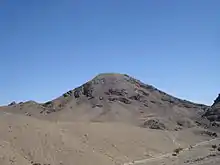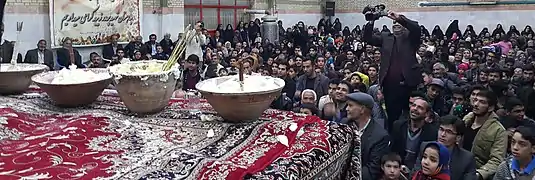Zibad
Zibad (Persian: زيبَد, also Romanized as Zībad)[1] is a village in Zibad Rural District, Kakhk District, Gonabad County, Razavi Khorasan Province, Iran. At the 2006 census, its population was 4243, in 1701 families.[2][3]
Zibad(Zeevad)
زيبَد | |
|---|---|
village | |
 Shelter of the last emperor of Persia, Yazdegerd III | |
 Zibad(Zeevad) | |
| Coordinates: 34°16′35″N 58°29′15″E | |
| Country | |
| Province | Razavi Khorasan |
| County | Gonabad |
| Bakhsh | Kakhk |
| Rural District | Zibad |
| Population (2006) | |
| • Total | 4,243 |
| Time zone | UTC+3:30 (IRST) |
| • Summer (DST) | UTC+4:30 (IRDT) |
Zibad, which means beautiful in Iranian, was a famous ancient city in Shahnameh. According to Shahnameh Ferdowsi (around 1000 AD), it was the place of a famous war called Davazdah Rokh(12 hero) between Iran and Turan. Zibad also has an ancient qanat that may be more than 1600 years old.

Zibad is famous for :
- its saffron and opium production.
- its ancient castle which was shelter of the last emperor of Persia, Yazdegerd III, the place of three ancient wars, and its Mithraism monument.
- its Qanat and darb e soufe a famous mountain wall rock, similar to Taq-e Bostan
- its water clock which had been in use continuously from 400BCE until 1950.
- Its Watermill producing flour and crushed wheat. The ancient water mill was at work until 1984 and destroyed for construction of a dam.


According to Callisthenes, the Persians were using water clocks in 328BCE to ensure a just and exact distribution of water from qanats to their shareholders for agricultural irrigation. The use of water clocks in Iran, especially in Zibad, dates back to 500BCE. Later they were also used to determine the exact holy days of pre-Islamic religions, such as the Nowruz, Chelah, or Yaldā - the shortest, longest, and equal-length days and nights of the years. The water clocks used in Iran were one of the most practical ancient tools for timing the yearly calendar. .[4]
Kūh-Zibad
Kūh-Zibad is famous because of the great historical events its peak also called Tir Mahi The terrain around Kuh-e zibad is mainly hilly. The highest point in the vicinity is 2775 meters above sea level, 17.7 km southeast of Qole-e Tir mahi. Around Kuh-e Zibad is very sparsely populated, with 5 inhabitants per square kilometer. Nearest society zibad, 8.5 km north of Kuh-e Zibad. The neighborhood around Kuh-e Zibad is barren with little or vegetation. In the neighborhood around are unusually many named mountains and valleys. A cold steppe climate prevailing in the region. The average annual temperature in the area is 17 °C. The warmest month is July when the average temperature is 30 °C, and the coldest is January, with 1 °C. Average annual rainfall is 211 mm (8 in). The rainiest month is February, with an average of 58 mm (2 in) of precipitation, and the driest is July, with 1 mm of precipitation. This mountain had been referred in some historical book such as shahnameh in Davazdah Rokhwar as the Zibad mountain and its eastern part is called black mountain or kuh Gonabad. the long range mountain called Qohestan and It extends from Bajestan to Birjand near the border with Afghanistan this rang mountain separate south Khorasan from Razavi Khorasan,part of this rang mountain near Kakhk is called black mountain or kuh e gonabad
Zibad Castle
Zibad Castle is one of the four historical monuments of Zibad village. Zibad Castle was registered in 2001 as national property in Iran, which is related to the history of pre-Islamic Iran, and is located in Gonabad In addition to the castle of Zibad, there are also the royal castle of Zibad nationally registered under the name of Shahab Castle in 2002. which is blived to be the Last shelter of the last Persian emperorYazdegerd III some historian had wrote After his defeat, he sought refuge at a miller near Marv, who, however, murdered in 651. the miller had reportedly killed Yazdegerd in order to obtain his jewelry,[5] whilst the Cambridge History of Iran states that the miller was sent by Mahoe Suri.[6] According to the history of Belazari Yazdegerd III was defeated in a war in province of Merv in the city of Gonabad. Nizak the army chief of Mahoe Suri in the Gonabad and according to the new research the war occurred in Zibad of gonabad. Regardless, the death of Yazdegerd marked the end of the Sasanian Empire, and made it less difficult for the Arabs to conquer the rest of Iran. All of Khorasan was soon conquered by the Arabs, who would use it as a base to attack Transoxiana.[5] The death of Yazdegerd thus marked the end of the last pre-Islamic Iranian empire after more than 400 years of rule. An empire–which had a generation earlier briefly conquered Egypt and Asia Minor, even reaching as a far as Constantinople, fell to a force of lightly equipped Arabs that were used to skirmishes and desert warfare. The heavy Sasanian cavalry was too sluggish and systematized to contain them; employed light-armed Arab or East Iranian mercenaries from Khorasan and Transoxiana would have been much more successful.[7] Several different and contradictory narratives about the death of Yazdgerd III have been left in historical books. According to the excavations of Zibd-Gonabad Fortress and according to oral narrations and the report of Blazeri and Habib Abdolhai,Dr Ajam and Abas Zmani(historical study magazin 1974) it seems that the narration related to the murder of Yazdgerd in Merw Mill is more mythical than the truth and what is closer to the truth is the narration of Al-Baladhuri in Kitab Futuh al-Buldan. that yazdgerd was killed in Gonabad .The main text of Blazeri's book The Fate of Yazdgerd III: Then he went to Khorasan, then he went to Janabad (Gonabad) he was welcomed and ruler of merv send Nizak Trkhan to welcom him in gonabad. but after weeks he asked the emperor to marry his daughter and the emperor refused and this caused a war and at the end Nizak attacked and defeated the king army and Destroyed and captured the remnants of the imperial forces. the battle was occurred in Zibad gonabad.[8] Mahoe Suri was probably from the House of Suren, one of the seven Parthian clans of the Sasanian state.[6] During the Islamic invasion of Iran, Yazdegerd III went to refuge in Marv; in his way to merv he stayed in gonabad Mahoe envoy warmly received them in gonabad.[9] Mahoe Suri used opportunity to secretly plot with the Hephthalite ruler Nizak against Yazdegerd.[6]
Sufeh Pir
Sufeh Pir is another famous place in zibad a holy cave believe to be the tomb of Piran Viseh in the Kūh-Zibad mountain. He is a Turanian figure in Shahnameh, the national epic of Greater Iran. Beside Shahnameh, Piran is also mentioned in other sources such as Tabari and Tha'ālibī. He is the king of Khotan and the spahbed of Afrasiab, the king of Turan.
According to the book of Dr. Abas Zamani Piran Viseh was buried in the cave of Sofe Zibad now called DarSufa Pir.
Culture

Iranian festivals such as Yaldā Night and Nowruz are celebrated in Zibad.
Geography
The mountain of Kūh-Zibad is located near Zibad, and is the second-highest mountain in Razavi Khorasan Province.
See also
References
| Wikimedia Commons has media related to Zibad. |
- Zibad can be found at GEOnet Names Server, at this link, by opening the Advanced Search box, entering "-3089466" in the "Unique Feature Id" form, and clicking on "Search Database".
- "Census of the Islamic Republic of Iran, 1385 (2006)". Islamic Republic of Iran. Archived from the original (Excel) on 2011-11-11.
- http://www.amar.org.ir/Portals/0/sarshomari90/Files/ABADY-90/os09.xls
- conference of Qanat in Iran - water clock in persiaد1383 آفتاب
- Kia 2016, p. 285.
- Zarrinkub 1975, p. 25.
- Shahbazi 1986, pp. 489–499.
- فتوحالبلدان،Al-Baladhuri in Kitab Futuh al-Buldan p569 صص ۵۶۸–۵۶۹
- Pourshariati 2008, pp. 261-262.
Bibliography
- Kia, Mehrdad (2016). The Persian Empire: A Historical Encyclopedia [2 volumes]: A Historical Encyclopedia. ABC-CLIO. ISBN 978-1610693912.
- Pourshariati, Parvaneh (2008). Decline and Fall of the Sasanian Empire: The Sasanian-Parthian Confederacy and the Arab Conquest of Iran. London and New York: I.B. Tauris. ISBN 978-1-84511-645-3.
- Shahbazi, A. Shapur (1986). "Army i. Pre-Islamic Iran". Encyclopaedia Iranica, Vol. II, Fasc. 5. London et al. pp. 489–499.
- Zarrinkub, Abd al-Husain (1975). "The Arab conquest of Iran and its aftermath". The Cambridge History of Iran, Volume 4: From the Arab Invasion to the Saljuqs. Cambridge: Cambridge University Press. pp. 1–57. ISBN 978-0-521-20093-6.


.png.webp)